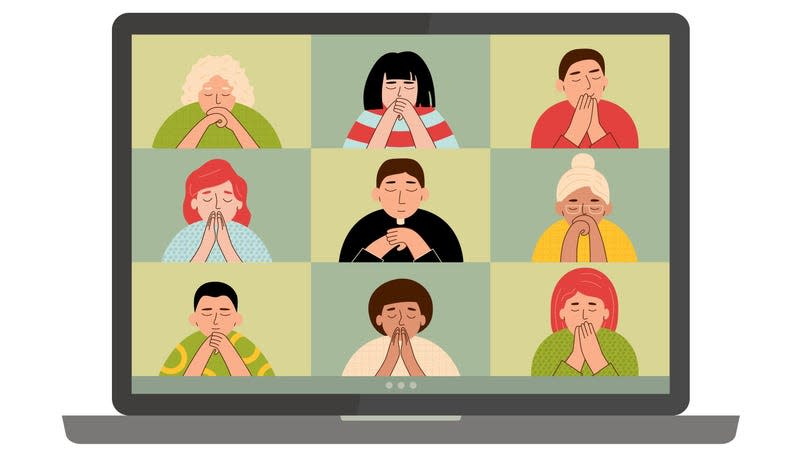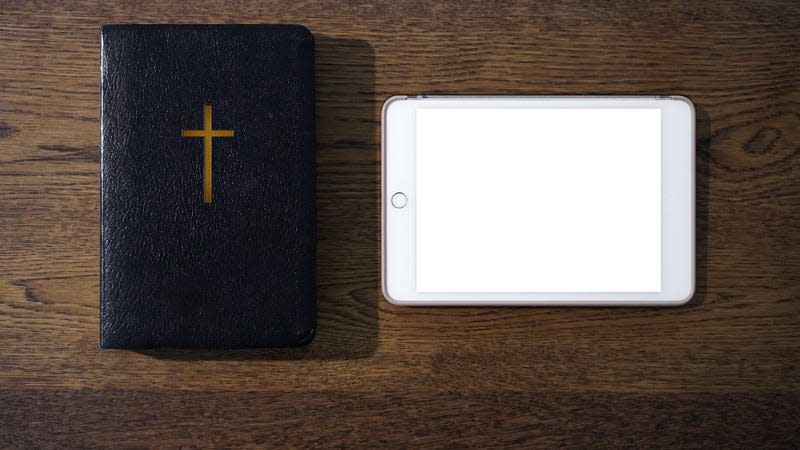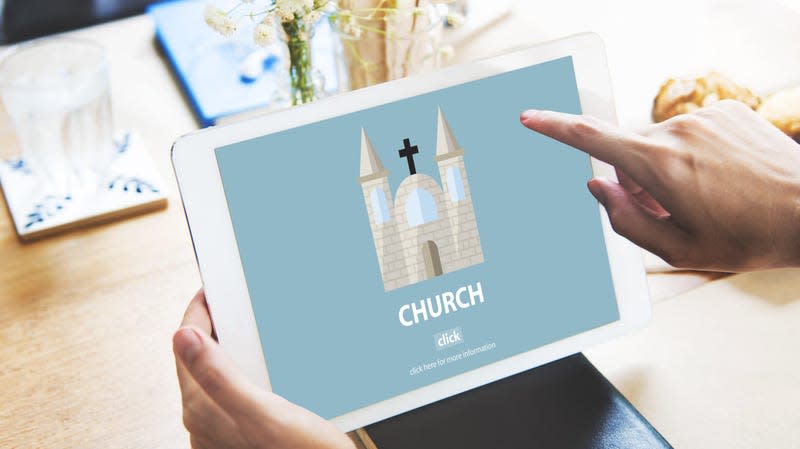More and More Americans Want to Attend Church Digitally, Study Finds

From a certain angle, you’d think that America had given up on religion. Our pop culture these days is about as secular as you can get and, for younger generations, organized religion seems increasingly like a thing to be avoided. To hear some tell it, you’d be hard pressed to find a millennial or Gen Z-er that wants to go anywhere near a church. But while religiosity may be waning in the U.S., the truth is that a majority of Americans are still connected to one faith or another. According to Pew Research, about 63 percent of Americans currently identify as Christian; another seven percent, meanwhile, say they are affiliated with a non-Christian faith, like Judaism or Buddhism. As of 2021, approximately 75 percent of Americans—or three out of four people—identified as religious, according to Pew.
In short: religion is still a major thing for most Americans. But how Americans interact with their respective faiths is notably changing.
Read more
As technology has become a larger and larger part of our lives, so too has the notion that it can be used to connect to a higher power. Notably, the covid-19 pandemic forced Americans to interact with their religious communities via more virtual means. Now, Americans are increasingly turning to tablets, laptops, and social media to tune into religious sermons and connect with spiritual communities. A recent study conducted by Pew shares some interesting insights about how Americans are digitizing their spiritual experiences. Here are some of the takeaways.
About 25 percent of U.S. adults watch remote religious services

The onset of the covid-19 pandemic appears to have had a big impact on the number of people who attend religious events virtually. A lot of congregations now stream their services live to the internet, which allows people not physically present to virtually attend via their tablet or laptop. The pandemic—which forced communities to socially distance themselves—clearly drove some would-be church-goers to opt for a safer, digitally-supported experience. That said, Pew writes that, while the number of people who reported virtual attendance seems to have gone up in recent years, a majority of people who reported doing so said they actually started doing it before the pandemic occurred...
Most regular viewers (66%) say they began watching services on screens before the pandemic. About a quarter say they started doing so during the pandemic. (The remainder either gave an inconsistent pattern of responses or declined to answer the question.)
It should also be noted that while a majority of Americans may be religious, a majority of them (57 percent) do not actually go to church regularly. This means that people who do go to church with any regularity are a statistical minority.
Only about 10 percent of U.S. adults said they exclusively watch virtual services

Yes, the number of U.S. adults who exclusively attend religious services online is about 10 percent. There is a slightly larger contingent (about 17 percent) who say that they tune in virtually but also go to church in person with some frequency. Why do folks tune in virtually? Aside from the safety concerns mentioned in the previous slide, Pew notes that there are a host of reasons that people commune online rather than in person...
There is no single reason why virtual religious services appeal to many Americans. When asked why they tune in, regular viewers tend to give multiple answers. But of six possible reasons offered in the survey, the most commonly chosen is convenience.
So, similar to how technology has made many other areas of life more convenient and easy to navigate, tech would appear to make—in the words of David Bowie—getting to the church on time that much easier.
That said, not all viewers of religious services are tuning in to a local service. Actually, Pew’s research shows that a majority of the people who attend church virtually (about 75 percent) actually use it to stream a service that isn’t located in their own community. The report shows that...
Nearly four-in-ten adults (38%) who regularly watch services online say the services they watch are offered by a house of worship in their local area. About a third (35%) say they watch services offered by a house of worship outside their local area, while a quarter say they watch services offered both by local and non-local congregations...Nearly three-quarters of virtual viewers watch services at a congregation they do not attend in person. This includes those who watch at least one congregation other than the one they attend most often in person (38% of virtual viewers) as well as those who do not have an in-person congregation (36%).
Two thirds of worshippers say they’re “highly satisfied” with virtual services

For religious folks, you’d think that sitting at your computer and watching a sermon wouldn’t be quite the same as seeing the real thing. But, overall, most people who use the internet to connect with their faith-based communities appear to be pretty satisfied with the experience. Only a small percentage of folks seem to think digital religion sorta sucks. According to Pew’s research...
About two-thirds of U.S. adults who regularly watch religious services online or on TV say they are generally “extremely” or “very” satisfied with these services. Nearly three-in-ten virtual worshippers (28%) say they are “somewhat” satisfied with the services they watch, and 5% say they are “not too” or “not at all” satisfied.
About 15 percent of Americans use apps to remind them to pray

Outside of using the internet to tune into religious services, the digitally spiritual also use tech for a number of other godly reasons. One is to remind them to pray. According to Pew’s research, at least 15 percent of Americans say they use an app to remind them to commune with a greater power—whatever that happens to be. Similar apps can also be used to remind users to read scripture. In general, it’s younger Americans who are using these apps, though a lot of older Americans also use them. Pew research shows that...
Americans ages 65 and older are slightly less likely than younger adults to use apps and websites for religious purposes. According to a scale measuring overall usage of multiple kinds of religious technology, 13% of people 65 and older are “heavy users” of apps and websites for religious reasons, compared with 16% to 18% of those in younger age brackets.
Lots and lots of Americans use the internet to engage with religious media

Given the overwhelming religiosity of the U.S. population and the digital media saturated culture we all live in, you’d think that tons of Americans were consuming religious content online. That presupposition is borne out somewhat by Pew’s research, which shows that two in ten Americans say they consume religious-themed content via online videos from sites like YouTube and TikTok. Another 15 percent, meanwhile, say they get religious content from podcasts. Somewhat surprisingly, however, a majority of Americans seem to prefer more traditional forms of religious media, like books and radio. Pew research shows...
About a third of U.S. adults (34%) say they read religion-focused books, which is more than the 20% who say they watch religion-focused videos online. And a quarter of U.S. adults report listening to religious radio stations – more than the 15% who listen to religion-focused podcasts.
Black Protestant denominations figure most highly in virtual attendance figures

One of the largest subsections of the virtually religious are members of Black Protestant communities, according to Pew. Research shows that...
Americans who belong to historically Black Protestant denominations are more frequent watchers of religious services than the other U.S. religious groups with sample sizes large enough to analyze. For example, about six-in-ten adults in historically Black Protestant denominations (58%) say they generally watch religious services on screens at least monthly or watched them in the month prior to the survey. This compares with 47% of evangelicals, 28% of mainline Protestants, 24% of Catholics and 19% of Jews.
Pew’s survey results also reveal that part of the reason for this is concern over the impacts of covid-19, which is known to have hit Black communities especially hard. Additional Pew research shows that Black communities show more concern over covid-19 than other groups.
But most people still prefer in-person religious events to virtual ones

As with most things in life, it’s hard to beat good ol’ fashioned original real life. So, for a majority of religious Americans, while they may like to tune into the occasional virtual sermon, they’d much rather prefer to have their butts in a pew. The research shows that...
Americans tend to give higher marks to worshipping together in person. While majorities express satisfaction with virtual services, even bigger shares of physical attenders say they feel extremely or very satisfied with the sermons (74%) and music (69%) at the services they attend in person.
So, while attending church via laptop may have its perks, clearly just getting in the car and heading to service on Sunday seems like a superior choice for many Americans. That said, who knows how new technologies may change the game when it comes to digital spirituality? Case in point: ChatGPT recently wrote a sermon for a church in Germany. What are the chances we’re going to start seeing a whole lot of AI in the pulpit? Similarly, can you imagine what “the metaverse” will eventually do in this department? Only time will tell if the new Apple Vision Pro ends up letting users meet the risen Jesus.
More from Gizmodo
Sign up for Gizmodo's Newsletter. For the latest news, Facebook, Twitter and Instagram.

